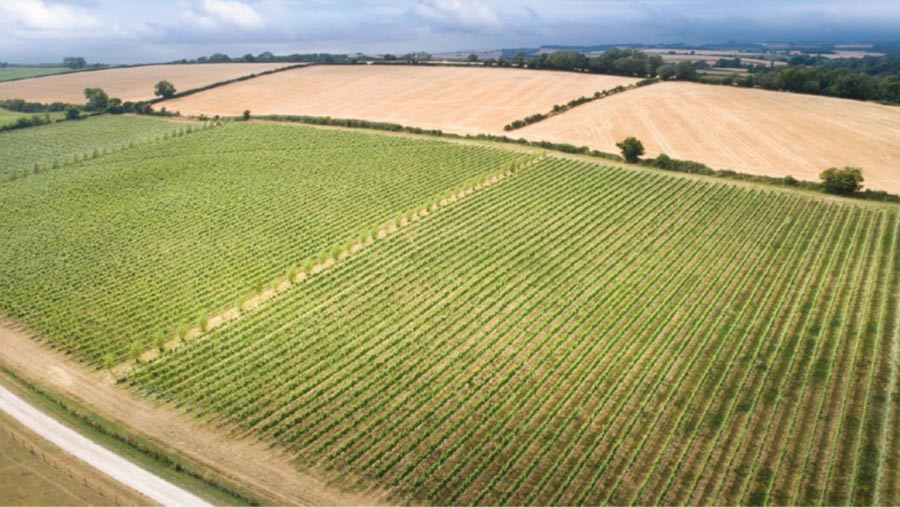Huge increase in UK land under vines and demand continuing
Demand for land for vineyards shows no sign of slowing, with huge growth in the UK wine sector in recent years and suitable plots selling at a premium.
According to the trade body WineGB, there are now about 800 vineyards in the UK and there has been a 70% increase in the area under vines in the past five years.
In 2020, 8.7m bottles of wine were produced in the UK, with industry experts forecasting this could rise to 40m in the next 20 years.
See also: Carbon, soil and wine central to plug BPS gap on Sussex farm
Though the Covid-19 pandemic has taken its toll on the sector, with businesses forced to close their doors, several UK wine producers reported a surge in sales during lockdown, as people sought out new drinks experiences to try at home.
Suitable land snapped up
The boom in UK wine has translated to strong demand for land suitable for planting vines and there is no sign of this letting up, said Nick Watson, senior director at Strutt & Parker.
Interested parties range from people looking for a couple of acres to start winemaking as a hobby, to operators with a strong commercial focus looking for sites upwards of 30 acres.
The best sites have free-draining, gentle south-facing slopes that are not exposed to strong winds or late frost, are less than 100m above sea level, and have the highest average temperatures and sunshine hours, according to Mr Watson.
Many buyers will also consider other factors such as the look and feel of the place, accessibility, and the potential to develop wine tourism ventures.
“Only a small proportion of the land that comes to the open market each year will be suitable for planting with vines, so most vineyard land must be proactively sought out and purchased privately,” said Mr Watson.
What buyers need to take into account
- Is the land suitable for a vineyard?
Many vineyards were just planted on land that was already owned without much consideration for the factors that produce good wine. - How old are the vines?
Seven to 15 years is considered the sweet spot. You can’t tell if vines are producing the right levels of sugar and acidity until they are five years old and they generally have a lifespan of about 30. - What varieties of grapes are being grown?
You want vines that can produce the wines that are most popular with consumers.
Vineyards that tick all the boxes can fetch about £30,000-£40,000/acre, said Mr Mansel Lewis, but there are only a handful of any scale sold each year.
“As such, any potential buyer tends to need to offer a premium to persuade a reluctant vendor to sell.
“This means that, while most arable land in the UK sells for between £8,000 and £10,000/acre, ground suitable for vineyard planting often sells for between £15,000 and £25,000/acre.”
The highest prices are seen in the hotspot areas of East and West Sussex, Kent, parts of Surrey and East Hampshire.
For existing vineyards, the number sold each year is small, with most transactions also taking place off-market.
The best vineyards can reach £30,000-£35,000/planted acre, according to Mr Watson, taking into account the value of the bare land, the cost of establishing the vines, and managing them to the point of production.
Quality English wine
Ed Mansel Lewis, Knight Frank’s head of viticulture, said there were two key vineyard sales that laid the foundation for the burgeoning UK market.
In 2010 Knight Frank was selling a farm in Kent for an owner keen to achieve a high price.
Advertising it as being suitable for vines attracted an English couple who had a vineyard in France and paid a 10% premium, establishing the high market price.
Four years later, Pierre Emmanuel Taitinger of the champagne brand bought another farm in Kent to plant grapes, which really kickstarted the market.
“It was a pivotal moment when people suddenly twigged that English sparkling wine might actually be really good,” said Mr Mansel Lewis.
“After that we saw sales achieving £15,000/acre for the first time.
“I wouldn’t be surprised to see land trading at £20,000/acre within two years. I know of five businesses that are each looking to acquire plots of a minimum of 80 acres, which is a significant size for vineyards.”
Sparkling wine needs an average growing season temperature of at least 13C between 1 April and 1 October, which has been seen consistently in parts of the UK since 2010.
“Data show that Kent, Essex, Sussex and Hampshire are still the best counties for growing vines, but it’s not just about what goes into the bottle,” he said.
“Vineyards in the right location can sit at the heart of a successful diversified rural business so you don’t need to be producing critically acclaimed vintages every year to create a viable wine business.”
What’s on the market?

Muston Vineyard © Savills
Muston Vineyard near Piddlehinton in Dorset is on the market with Savills for offers above £1.2m.
It includes 43 acres of English sparkling wine-producing vines of the Chardonnay, Pinot Noir and Pinot Meunier varieties, pasture and mature woodland.
Planning permission for a 10,000sq ft agricultural building has been secured.
